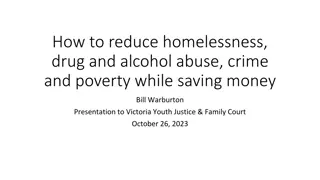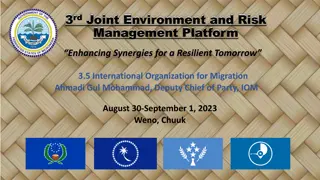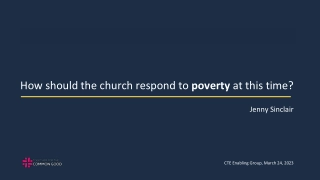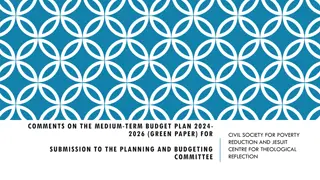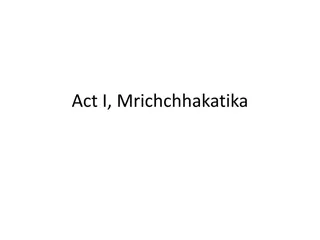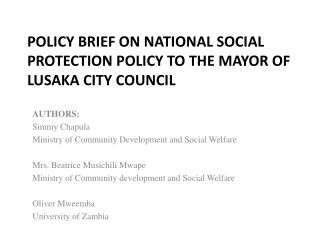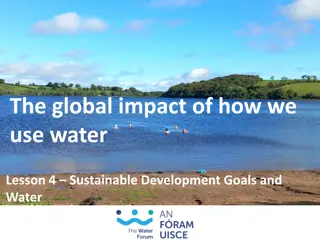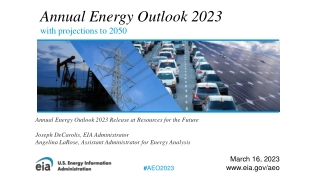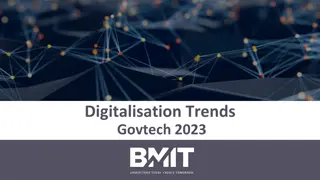Challenges and Trends in Poverty Reduction Efforts
The workshop on optimizing poverty reduction in Arab States highlighted key challenges and trends, including the projected extent of extreme poverty by 2030, the impact of COVID-19 on vulnerable populations, disparities in government spending, and the urgent need for increased investment to improve economic opportunities and social protection.
Download Presentation
Please find below an Image/Link to download the presentation.
The content on the website is provided AS IS for your information and personal use only. It may not be sold, licensed, or shared on other websites without obtaining consent from the author. Download presentation by click this link. If you encounter any issues during the download, it is possible that the publisher has removed the file from their server.
Presentation Transcript
Session 5: Poverty trends and challenges Workshop on Optimizing poverty reductions in Arab States: Measurement and tools to inform policies Hashemite Kingdom of Jordan, Amman CLAUDIO SANTIBANEZ, DIVISION OF INCLUSIVE SOCIAL DEVELOPMENT DESA
World Bank Data Blog: Poverty is back to pre- COVID levels globally, but not for low-income countries NISHANT YONZAN DANIEL GERSZON MAHLER CHRISTOPH LAKNER |OCTOBER 03, 2023
2023: 44.04 2010: 6.39
2023: 10.11 2010: 1.85
1.Projected Extent of Extreme Poverty (2030) If current trends persist, an estimated 575 million individuals will still endure extreme poverty by 2030. 2.National Poverty Reduction Only one-third of countries are on track to halve their national poverty levels by 2030. 3.Impact of COVID-19 Crisis Despite expanded social protection during the pandemic, over 4 billion people globally remain entirely unprotected. 4.Vulnerable Population Groups Many vulnerable demographics, such as the youth and the elderly, lack coverage in statutory social protection programs. 5.Disparity in Government Spending Advanced economies allocate a notably higher share of government spending to crucial services like education, health, and social protection compared to emerging and developing economies. 6.Need for Action and Investment Urgent action and increased investment are necessary to improve economic opportunities, enhance education, and extend social protection to all, especially the most marginalized.
VNRs 2023 VNRs 2023
Quality education for indigenous communities Teacher training & shortage Education to refugees Education for children with disabilities EDUCATION Digitalization in schools Lowachievers students Education Demographic Different types of Education Higher education in rural areas Inequality Migration & Refugees Ageing Cultural change Accelerate LNOB actions Water, quality, managment, & sanitation Poverty, LNOB SOCIAL INCLUSION SOCIAL DEVELOPMENT Underfunding of social programmes PWD housing Local govt and Municipal institutional capacity Social Protection PWD social, economic inclusion Reducing social stigma, discrimination Malnutrition & Quality food Obesity and quality food Health related to environment Higher demand for health from an aging population YOUTH Youth emigration HEALTH RELATED Health Youth professionals Young civil servants unemployment Antibiotic resistance Health equality & universal health coverage
Measures taken by VNR 2023 countries to combat poverty and inequality include Creating an enabling environment for increased local and foreign direct investment Strengthening social protection systems and safety nets Focusing on economic growth, job creation, improving livelihoods, and reducing vulnerabilities to climate change Investments in social infrastructure and service provision Strategy for sustainable graduation from poverty Establishing new initiatives in the areas of social insurance, social safety nets, and labor market support programs Targeted support for the poor and marginalized groups New national model of accounting
Compare with literature suggestion (PB 107) Expanding social protection programs to vulnerable and marginalized groups. Investing in education, health, and other basic services. A progressive taxation system towards comprehensive public service provision. Encouraging equal access to productive assets for all individuals. Increasing budget allocations and improving the efficiency of public expenditure. Implementing policies to promote gender equality and improve economic participation of women. Increasing transparency and participation in decision-making Promoting job creation and productive employment.
1. Vietnam: Implemented general poverty reduction mechanisms and policies, gradually reduced and abolished subsidy policies, increased repayable and conditional support policies, and achieved impressive poverty reduction regardless of the measurement methodologies. 2. Zambia: Implemented investments in social infrastructure and service provision, enhanced capacities to withstand effects of climate change, strengthened social protection systems and safety nets, affirmative action for marginalized groups, and created an enabling environment for increased local and foreign direct investment. Measures to Combat Poverty and Inequality: 3. Uzbekistan: Implemented state support for income growth, a new national model of accounting, targeted support for the poor, and employment opportunities for those from low-income families. 4. Rwanda: Implemented scaling up social protection interventions, developed a Covid-19 Social Protection Response and Recovery Plan, and developed a strategy for sustainable graduation from poverty. 5. Romania: Implemented policies and measures to reduce the number of citizens living in severe and relative poverty, encouraging participation in the labor market, and developing the protection and social assistance system.
6. Saudi Arabia: Implemented steps to reduce income inequality through social safety nets and poverty reduction programs, improving existing programs, and establishing new initiatives in the areas of social insurance, social safety nets, and labor market support programs. 7. Slovakia: Implemented measures to reduce poverty and inequality under SDGs 1, 2, and 10, with observed progress but challenges with the implementation of antidiscrimination laws and insufficient deterrence for discrimination. Measures to Combat Poverty and Inequality: 8. Guyana: Implemented actions to expand access to technology, investments in the social sector, and infrastructure and incentives for private sector expansion. 9. Barbados: Implemented a multi-pronged approach to addressing systemic and structural challenges perpetuating poverty, focusing on economic growth, job creation, improving livelihoods, reducing vulnerabilities to climate change, and institutional strengthening of the social protection system. 10. Bahrain: Implemented policies and programs aimed at promoting job creation, reducing unemployment, and addressing the efficiency of social support and protection, including the allocation of government subsidies to eligible individuals. 11. Timor Leste: Aims to eradicate extreme poverty, reduce poverty by at least half, implement social protection systems, ensure equal rights to resources, build resilience to environmental, economic and social disasters, and fund the successful implementation of poverty eradication policies.
Peace, security, poverty and inequality Wars and violent conflict While poverty has been broadly reduced across the globe since 1990, it increased in conflict-affected countries. The gap between peaceful and conflict-affected countries in their progress on poverty reduction is predicted to widen further. By 2030, two-thirds of the world s extreme poor will live in fragile and conflict- affected countries. Almost 70% of the 193 million people suffering from acute hunger live in countries with violent conflict and instability.
Peace: Rebuilding the state, strengthening the social contract and social cohesion, and encouraging non-violent political participation are the critical elements for building peace in conflict-affected areas. Decent Work: Automation and digitization will continue to drive changes in the workplace and employment relationships, which should be managed in a way that ensures that gains in productivity are matched by wider social benefits. Investment in skills is especially important in the face of automation and digitization to ensure workers remain competitive in the changing labour market. Public policies play a crucial role in promoting Gender Equity and Labour Market Outcomes. Greater Equality: Horizontal inequalities based on group membership are associated with a range of negative political, social, and economic outcomes in diverse contexts, and data availability is a constraint to better measuring them. Affirmative action can (and has) played a role in addressing both vertical and horizontal inequalities in different contexts, but implementation and design matter significantly, and policy learning would enhance their impact.
DESA Policy Briefs series on economic insecurity DESA Policy Briefs series on economic insecurity
Economic insecurity Economic insecurity Poverty Economic insecurity and poverty are interconnected issues that affect people's ability to cope and recover from economic shocks. Structural factors such as employment instability and joblessness can contribute to rising economic insecurity and inequality. Trust Inequality Economic insecurity affects citizens policy preferences, including support for specific political parties and leaders, and even attitudes towards the role of government itself. Economic insecurity Economic insecurity, job instability, and dissatisfaction with the quality of public services can lead to reduced trust in public institutions, creating disengagement from public mandates and hinder compliance with laws and recommendations, affecting overall societal wellbeing and functioning.
Final points: Address the several interlinkages of the SDGs affecting SDG1. A comprehensive focus on poverty elimination may include an understanding on how economic insecurity, inequality and institutional trust accelerate poverty goals. WSS 2025.




